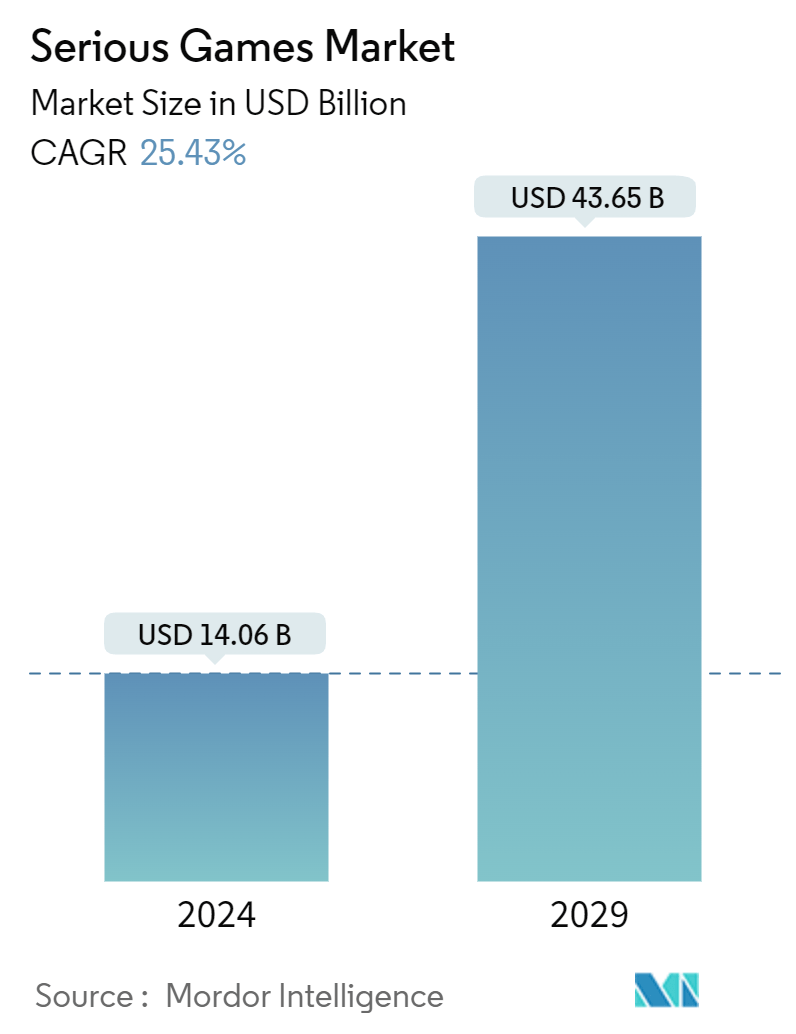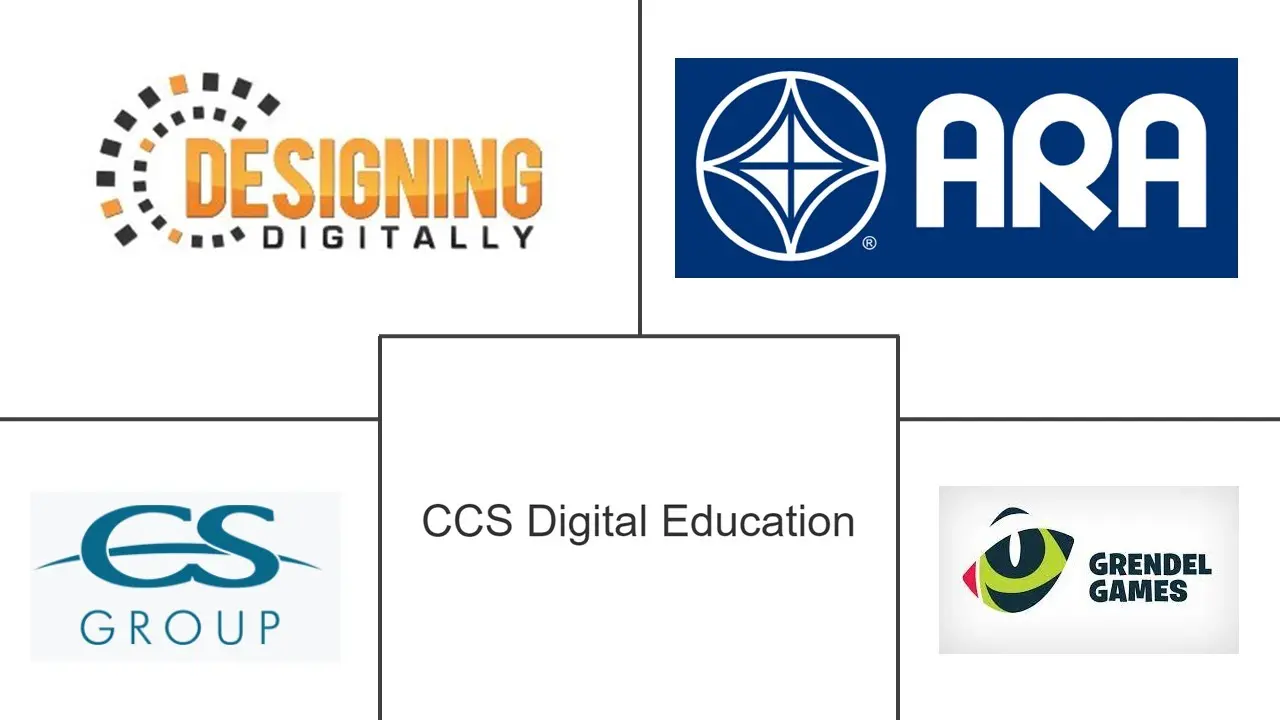Market Size of Serious Games Industry

| Study Period | 2019 - 2029 |
| Market Size (2024) | USD 14.06 Billion |
| Market Size (2029) | USD 43.65 Billion |
| CAGR (2024 - 2029) | 25.43 % |
| Fastest Growing Market | Middle East and Africa |
| Largest Market | Asia-Pacific |
Major Players
*Disclaimer: Major Players sorted in no particular order |
Serious Games Market Analysis
The Serious Games Market size is estimated at USD 14.06 billion in 2024, and is expected to reach USD 43.65 billion by 2029, growing at a CAGR of 25.43% during the forecast period (2024-2029).
The serious games market is evolving rapidly, driven by advancements in mobile technology and increasing demand for engaging learning tools across various industries. Serious games, which are designed for educational, training, or simulation purposes beyond entertainment, are gaining traction in sectors like education, healthcare, government, and corporate training. These games blend interactive experiences with practical learning outcomes, expanding their application in professional and educational environments. As the global focus shifts toward digital transformation and innovative training methods, serious games are becoming a critical tool for improving engagement, knowledge retention, and performance.
- Technology Integration in Serious Games: The market is seeing a surge in mobile-based platforms, cloud-based infrastructure, and immersive technologies such as virtual and augmented reality (VR/AR). These technologies enhance the effectiveness of serious games by creating immersive and interactive learning environments that adapt to various educational needs. Artificial intelligence (AI) is also allowing for more personalized learning experiences, making serious games more impactful for users.
- Broad Industry Adoption: Serious games are being adopted across sectors. The healthcare industry uses them for simulation training and patient education, while educational institutions implement them for interactive learning. In industries like automotive and retail, serious games facilitate employee training and customer engagement, broadening their market appeal.
Mobile Educational Games Transform Learning
- The increasing use of mobile-based educational games is a significant driver of the serious games market. Mobile devices make these games easily accessible to a broader audience. Educational games that run on smartphones and tablets are popular due to their portability and convenience, allowing users to learn anytime, anywhere. These games provide interactive content that enhances knowledge retention and learning efficiency.
- Integration into Education Systems: As education systems worldwide adapt to digital platforms, mobile games offering gamified experiences are being incorporated into curricula. Serious games promote critical thinking and problem-solving through engaging formats, fostering dynamic learning environments. Both students and professionals are increasingly relying on mobile applications for continuous learning.
- Corporate Training Benefits: In the corporate world, mobile-based serious games offer an engaging, cost-effective solution for employee training, particularly in industries like healthcare and aviation, where simulation and role-playing are key to training effectiveness. This trend aligns with the growing demand for serious games in corporate training as a modern training tool.
Improved Learning Outcomes Fuel Serious Games Adoption
- The improved learning outcomes associated with serious games are driving adoption across various sectors. Research shows that serious games enhance user engagement and knowledge retention compared to traditional learning methods, proving particularly valuable in education and corporate training.
- Healthcare Applications: In healthcare, serious games simulate medical procedures, offering professionals hands-on experience in a risk-free environment. This leads to improved confidence and competency. Similarly, in education, serious games help students grasp complex concepts by allowing interactive experimentation.
- Data-Driven Personalization: The rise of data analytics in education and training has amplified the effectiveness of serious games. By tracking user progress, educators and trainers can personalize content to meet individual learning needs. This personalized learning not only increases user satisfaction but also delivers more efficient learning outcomes.
Serious Games Industry Segmentation
Serious games are digital applications primarily prepared for training and education purposes, where the key function is to provide knowledge, training, memorize, inform, and teach the end-users. It is mainly utilized as a tool for knowledge transfer by methods that use gameplay (against self/others) and a penalty/reward system to assess learning in a game-based approach. This study includes a regional analysis and discusses the overall demand for solutions in several end-user industries, including healthcare, education, retail, media, entertainment, automotive, government, and others. The analysis of COVID-19's effects on the market and how those effects have been taken into account for present-day market estimates and long-term forecasts are also covered in the research.
The serious games market is segmented by application (advertising and marketing, simulation training, learning and education), by end-user industry (healthcare, education, retail, media and entertainment, automotive, government), by geography (North America, Europe, Asia Pacific, rest of the World). The market sizes and forecasts are provided in terms of value (USD) for all the above segments.
| By Application | |
| Advertising and Marketing | |
| Simulation Training | |
| Learning and Education | |
| Other Applications |
| By End-User Industry | |
| Healthcare | |
| Education | |
| Retail | |
| Media and Entertainment | |
| Automotive | |
| Government | |
| Other End-user Industries |
| By Geography*** | |
| North America | |
| Europe | |
| Asia | |
| Australia and New Zealand | |
| Latin America | |
| Middle East and Africa |
Serious Games Market Size Summary
The Serious Games Market is poised for substantial growth, driven by its application across various sectors such as education, training, and healthcare. These games are increasingly recognized for their ability to enhance problem-solving, social skills, and decision-making abilities. The market is witnessing a surge in the adoption of enterprise gaming systems, particularly for employee training and sustainability education. The financial services sector is also embracing serious gaming to simplify complex simulation training. The COVID-19 pandemic has accelerated the integration of serious games into e-learning platforms, enhancing student engagement and motivation. The Asia-Pacific region is experiencing significant growth due to rising awareness, mobile-based gaming demand, and government support for educational gaming.
In the healthcare sector, serious games are being utilized to impart procedural and cognitive skills, with collaborations between organizations like SIMS and the Serious Games Association facilitating their development and implementation. The market is characterized by intense competition, with major players engaging in strategic mergers and acquisitions to strengthen their positions. Recent developments include acquisitions by companies like Brightcove Inc. and MPS Interactive Systems Limited, as well as the launch of new educational games by Google Arts & Culture Lab. These trends underscore the market's dynamic nature and its potential for continued expansion across diverse applications.
Serious Games Market Size - Table of Contents
-
1. MARKET INSIGHTS
-
1.1 Market Overview
-
1.2 Industry Attractiveness - Porter's Five Forces Analysis
-
1.2.1 Bargaining Power of Suppliers
-
1.2.2 Bargaining Power of Consumers
-
1.2.3 Threat of New Entrants
-
1.2.4 Intensity of Competitive Rivalry
-
1.2.5 Threat of Substitute Products
-
-
1.3 Technology Snapshot
-
1.4 Assessment of Impact of COVID-19 on the Industry
-
-
2. MARKET SEGMENTATION
-
2.1 By Application
-
2.1.1 Advertising and Marketing
-
2.1.2 Simulation Training
-
2.1.3 Learning and Education
-
2.1.4 Other Applications
-
-
2.2 By End-User Industry
-
2.2.1 Healthcare
-
2.2.2 Education
-
2.2.3 Retail
-
2.2.4 Media and Entertainment
-
2.2.5 Automotive
-
2.2.6 Government
-
2.2.7 Other End-user Industries
-
-
2.3 By Geography***
-
2.3.1 North America
-
2.3.2 Europe
-
2.3.3 Asia
-
2.3.4 Australia and New Zealand
-
2.3.5 Latin America
-
2.3.6 Middle East and Africa
-
-
Serious Games Market Size FAQs
How big is the Serious Games Market?
The Serious Games Market size is expected to reach USD 14.06 billion in 2024 and grow at a CAGR of 25.43% to reach USD 43.65 billion by 2029.
What is the current Serious Games Market size?
In 2024, the Serious Games Market size is expected to reach USD 14.06 billion.

